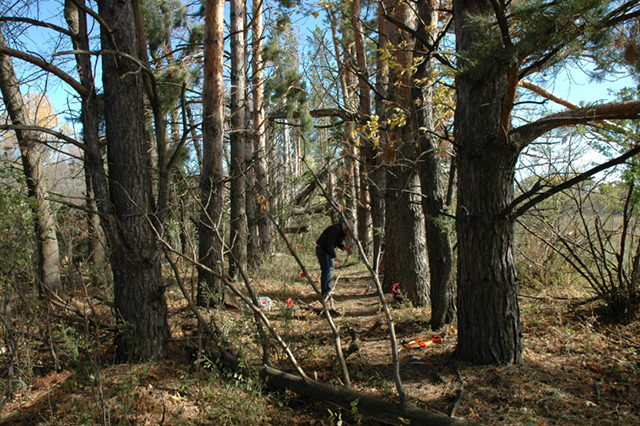
Agroforestry Helps Protect Crops and the Environment
 |
Dr. Tom Sauer is a Supervisory Research Soil Scientist at the National Laboratory for Agriculture and the Environment in Ames, IA. His work involves research into land use change effects on carbon sequestration and soil properties. His current focus is on evaluating agroforestry systems for their potential as climate change adaptation practices. |
Welcome Dr. Sauer to Under the Microscope.
UM – What is agroforestry, and how does it differ from other agricultural practices?
TS - Agroforestry is the integration of trees or shrubs and crops on the same area of land. Agroforestry practices are different from most other agricultural practices in that the perennial woody vegetation is managed in coordination with crops to optimize the production of multiple products and ecosystem services in the same space.
UM – What are the benefits of agroforestry?
TS - Some of the benefits include diversification of products and income, ecosystem services such as carbon sequestration, water quality improvement, pollinator habit creation, and climate change adaptation by modifying the local microclimate.
UM – The practice of agroforestry has been around for centuries. How has it evolved?
TS - Most agroforestry practices mimic a natural system. Forest farming is adapted from tropical home gardens, where multiple species within a multi-layered canopy were managed to provide food from several different plants. A silvopasture is designed to function like a savannah with widely spaced trees to provide shade for grazing animals. Agroforesters have used these natural systems as models to design practices, first in the tropics and more recently in temperate regions.
 Five row red cedar windbreak at the University of Nebraska-Lincoln West Central Research, Extension and Education in North Platte, NE. Tom Sauer, D4527-1).
Five row red cedar windbreak at the University of Nebraska-Lincoln West Central Research, Extension and Education in North Platte, NE. Tom Sauer, D4527-1).
UM – Windbreaks have a historical legacy in the United States, especially in the Great Plains/Dust Bowl region. Please explain the reasoning behind the windbreaks there and how they have helped farmers and residents since their development.
TS - Windbreaks are rows of trees planted on field borders or around farm sites to reduce wind speed. During an extended drought in the 1930s, USDA administered the Prairie States Forestry Project (PSFP), resulting in the establishment of over 18,000 miles of windbreaks in six Great Plains states. The primary goals were to reduce wind erosion and protect crops during drought conditions. The practice was recognized for its effectiveness and became popular in these states as numerous other plantings followed in the decades since the PSFP ended.
UM – I understand that tree windbreaks are particularly effective in semiarid areas like the Great Plains, the Russian steppes, or regions with hot, strong winds. Can windbreaks be established in other places, such as in an urban or residential environment?
TS - There is growing interest in using trees in urban settings to reduce "heat island" effects. Trees have the potential to cool urban environments by providing shade and through evaporative cooling as water evaporates from leaves. Deciduous trees on the south side of homes provide shade in summer and allow light in the winter. Trees on the upwind side of homes or buildings can also block winds and reduce heating costs in winter. There are well-established guidelines for tree size and spacing for home energy conservation.
 Iowa State University M.S. graduate student Ala' Khaleel measuring soil water infiltration near red cedar trees in Decatur County, IA.. Tom Sauer, D4528-1).
Iowa State University M.S. graduate student Ala' Khaleel measuring soil water infiltration near red cedar trees in Decatur County, IA.. Tom Sauer, D4528-1).
UM – Climate change has become a significant global issue. How can agroforestry and windbreaks help with mitigating the consequences of climate change?
TS - All agroforestry practices modify the local microclimate by reducing wind or providing shade. It is thus possible to establish and manage the tree component of agroforestry practices to achieve desired changes in wind speed, temperature, and other climate variables. There is great potential and flexibility in these practices to help producers adapt to climate change.
UM – Why should today's farmers, growers, and ranchers consider implementing windbreaks on their land?
TS - A survey of four Great Plains states in the 2010s showed that tree windbreaks are still a common practice in these states. The continued use of the practice indicates that landowners recognize their benefits. Recently, there was a report indicating a trend of increasing wind erosion in the Great Plains, which remain vulnerable to drought. Tree windbreaks are a good drought mitigation practice—years of research in the U.S., Russia, Canada, and Australia have all documented the crop yield benefits of tree windbreaks during drought years.

Iowa State University M.S. graduate student Ala' Khaleel collecting tree tissue samples in a ponderosa pine windbreak in Sargent County, ND planting in 1936 by the Prairie States Forestry Project. (Tom Sauer, D4529-1).
UM – How can consumers benefit from windbreaks?
TS - Tree windbreaks help make agroecosystems more resilient. More resilient systems are less prone to wide variation in yield due to climate extremes, so more stable production should translate into more stable food prices to consumers. Windbreaks can also be used to protect vegetable fields and orchards from high winds that can damage young plants or fruit.
UM – What are the most significant challenges to agroforestry and windbreak establishment?
TS - To participate in agroforestry practices and establish windbreaks, landowners are giving up some of their land for the trees, so they need to be convinced that the lost area will be compensated for by improved crop production, marketable tree products, or a more resilient production system. For this reason, we've focused on promoting agroforesty practices for marginal lands, where the yield of the land occupied by the trees is low, but the trees have greater potential to enhance the yield of the adjacent area.
 End view of five row red cedar windbreak at the University of Nebraska-Lincoln West Central Research, Extension and Education in North Platte, NE. (Tom Sauer, D4530-1).
End view of five row red cedar windbreak at the University of Nebraska-Lincoln West Central Research, Extension and Education in North Platte, NE. (Tom Sauer, D4530-1).
UM – What do you see as the next step in your work?
TS - We are working on characterizing windbreak and silvopasture effects on local microclimate at long-term research sites in Nebraska and Arkansas. We are building teams of collaborators and hope to create a more comprehensive assessment of effects than has been possible in the past. As we experience weather variations, we'll be able to monitor the functioning of our systems and more accurately predict their utility as climate change adaptation practices.
UM – Where can people learn more about ARS's work in agroforestry?
TS - Due to its integrative qualities, agroforestry research in ARS occurs at multiple locations and across several national programs but is concentrated in the Natural Resources and Sustainable Agricultural Systems Program Area.
A summary of ARS research on agroforestry can be found in USDA's Agroforestry Strategic Framework.
The Forest Service published a report on agroforestry and climate change.
Our University of Arkansas and USDA collaborators produced a video on our long-term silvopasture research in Arkansas.
University of Minnesota collaborators produced a video on our red cedar windbreak study. – by Georgia Jiang, ARS Office of Communications.
